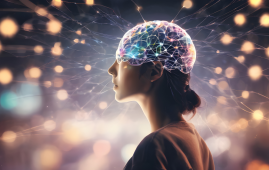

High-Tech Video Optimization in Our Brain: How the Brain Unblurs Vision During Movement
Researchers at the Institute of Science and Technology Austria (ISTA), led by Professor Maximilian Jösch, have discovered how the brain corrects visual distortions caused by movement. This groundbreaking study, published in Nature Neuroscience, reveals that a specific brain region, the ventral lateral geniculate nucleus (vLGN), plays a crucial role in stabilizing vision during motion in animals and likely humans.
The team found that the vLGN, located in the lateral thalamus, integrates motor and sensory signals from across the brain to predict and minimize movement-induced visual distortions. This process, which happens early in visual processing, ensures that images stay sharp even during rapid movement, before the information is passed on to other brain areas responsible for complex visual interpretation.
The discovery came through a combination of advanced techniques, including a custom-built two-photon microscope that allowed the scientists to observe the brains of awake, behaving mice in a virtual reality setup. The researchers observed that the vLGN receives copies of motor commands, which it uses to “unblur” visual signals as the eyes move. This mechanism is akin to how a Formula 1 race car driver’s eye adapts to fast movement, preventing blurriness in the footage, and works similarly to onboard camera stabilization.
Unlike previous studies that focused on later stages of visual processing, this research highlights the importance of compensating for movement early on. It suggests that this core function in the vLGN may be fundamental across the mammalian brain, offering insights that could apply to humans as well.
The team’s use of cutting-edge technologies, including virtual reality and calcium imaging, provided a detailed look at how the brain stabilizes vision during action. This study not only reveals how the brain’s visual system compensates for motion but also opens doors for future research into how these mechanisms function in primates and humans.
More Information: A thalamic hub-and-spoke network enables visual perception during action by coordinating visuomotor dynamics, Nature Neuroscience (2025). DOI: 10.1038/s41593-025-01874-w
more recommended stories
 How Soybean Oil Impacts Weight Gain and Metabolism
How Soybean Oil Impacts Weight Gain and MetabolismWhy Soybean Oil May Affect Metabolism.
 Coffee and Cognitive Function: Evidence Review
Coffee and Cognitive Function: Evidence ReviewA new narrative review in Cureus.
 Colorectal Cancer Screening Rates Low in Adults 45–49
Colorectal Cancer Screening Rates Low in Adults 45–49Recent UCLA research reveals that colorectal.
 Gut Immune Cells and Long-Lasting Antiviral Protection.
Gut Immune Cells and Long-Lasting Antiviral Protection.Breakthrough Findings on How Gut Immune.
 Mild Pancreatic Duct Dilatation Signals Higher Cancer Risk
Mild Pancreatic Duct Dilatation Signals Higher Cancer RiskEarly Structural Changes Offer Critical Clues.
 How the Uterus Senses Force During Labor: New Insights
How the Uterus Senses Force During Labor: New InsightsA new study published in Science.
 Fat-Free Mass and Brain Outcomes in Preterm Babies
Fat-Free Mass and Brain Outcomes in Preterm BabiesEarly Fat-Free Mass May Hold the.
 How Hormones Shape Dopamine-Driven Learning
How Hormones Shape Dopamine-Driven LearningNYU Study on Hormones and Cognitive.
 Protein Pair Guides Chromosome Alignment in Mitosis
Protein Pair Guides Chromosome Alignment in MitosisKey Points A joint research team.
 Intensive mind-body retreat rapidly alters brain function
Intensive mind-body retreat rapidly alters brain functionAn intensive mind-body retreat combining meditation,.

Leave a Comment